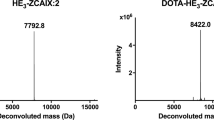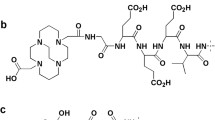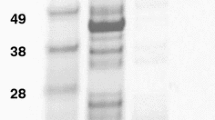Abstract
Purpose
Affibody molecules are low molecular weight proteins (7 kDa), which can be selected to bind to tumour-associated target proteins with subnanomolar affinity. Because of rapid tumour localisation and clearance from nonspecific compartments, Affibody molecules are promising tracers for molecular imaging. Earlier, 99mTc-labelled Affibody molecules demonstrated specific targeting of tumour xenografts. However, the biodistribution was suboptimal either because of hepatobiliary excretion or high renal uptake of the radioactivity. The goal of this study was to optimise the biodistribution of Affibody molecules by chelator engineering.
Materials and methods
Anti-HER2 ZHER2:342 Affibody molecules, carrying the mercaptoacetyl-glutamyl-seryl-glutamyl (maESE), mercaptoacetyl-glutamyl-glutamyl-seryl (maEES) and mercaptoacetyl-seryl-glutamyl-glutamyl (maSEE) chelators, were prepared by peptide synthesis and labelled with 99mTc. The tumour-targeting capacity of these conjugates was compared with each other and with the best previously available conjugate, 99mTc-maEEE-ZHER2:342, in nude mice bearing SKOV-3 xenografts. The tumour-targeting capacity of the most promising conjugate, 99mTc-maESE-ZHER2:342, was compared with radioiodinated ZHER2:342.
Results
All novel conjugates demonstrated successful tumour targeting and a low degree of hepatobiliary excretion. The renal uptakes of serine-containing conjugates, 33 ± 5, 68 ± 21 and 71 ± 10%IA/g, for99mTc-maESE-ZHER2:342, 99mTc-maEES-ZHER2:342 and 99mTc-maSEE-ZHER2:342, respectively, were significantly reduced in comparison with 99mTc-maEEE-ZHER2:342 (102 ± 13%IA/g). For 99mTc-maESE-ZHER2:342, a tumour uptake of 9.6 ± 1.8%IA/g and a tumour-to-blood ratio of 58 ± 6 were reached at 4 h p.i.
Conclusions
A combination of serine and glutamic acid residues in the chelator sequence confers increased renal excretion and relatively low renal uptake of 99mTc-labelled Affibody molecules. In combination with preserved targeting capacity, this improved imaging of targets in abdominal area.





Similar content being viewed by others
References
Britz-Cunningham SH, Adelstein SJ. Molecular targeting with radionuclides: state of the science. J Nucl Med 2003;44:1945–61.
Boswell CA, Brechbiel MW. Development of radioimmunotherapeutic and diagnostic antibodies: an inside-out view. Nucl Med Biol 2007;34:757–78.
Behr TM, Gotthardt M, Barth A, Behe M. Imaging tumors with peptide-based radioligands. Q J Nucl Med 2001;45:189–200.
Batra SK, Jain M, Wittel UA, Chauhan SC, Colcher D. Pharmacokinetics and biodistribution of genetically engineered antibodies. Curr Opin Biotechnol 2002;13:603–8.
Huhalov A, Chester KA. Engineered single chain antibody fragments for radioimmunotherapy. Q J Nucl Med Mol Imaging 2004;48:279–88.
Cortez-Retamozo V, Lauwereys M, Hassanzadeh Gh G, Gobert M, Conrath K, Muyldermans S, et al. Efficient tumor targeting by single-domain antibody fragments of camels. Int J Cancer 2002;98:456–62.
Binz HK, Amstutz P, Pluckthun A. Engineering novel binding proteins from nonimmunoglobulin domains. Nat Biotechnol 2005;23:1257–68.
Tolmachev V, Orlova A, Nilsson FY, Feldwisch J, Wennborg A, Abrahmsen L. Affibody molecules: potential for in vivo imaging of molecular targets for cancer therapy. Expert Opin Biol Ther 2007;7:555–68.
Nilsson FY, Tolmachev V. Affibody molecules: new protein domains for molecular imaging and targeted tumor therapy. Curr Opin Drug Discov Devel 2007;10:167–75.
Orlova A, Magnusson M, Eriksson TL, Nilsson M, Larsson B, Hoiden-Guthenberg I, et al. Tumor imaging using a picomolar affinity HER2 binding affibody molecule. Cancer Res 2006;66:4339–48.
Hudis CA. Trastuzumab–mechanism of action and use in clinical practice. N Engl J Med 2007;357:39–51.
Zidan J, Dashkovsky I, Stayerman C, Basher W, Cozacov C, Hadary A. Comparison of HER-2 overexpression in primary breast cancer and metastatic sites and its effect on biological targeting therapy of metastatic disease. Br J Cancer 2005;93:552–6.
Tolmachev V, Nilsson FY, Widstrom C, Andersson K, Rosik D, Gedda L, et al. 111In-benzyl-DTPA-ZHER2:342, an affibody-based conjugate for in vivo imaging of HER2 expression in malignant tumors. J Nucl Med 2006;47:846–53.
Orlova A, Tolmachev V, Pehrson R, Lindborg M, Tran T, Sandstrom M, et al. Synthetic affibody molecules: a novel class of affinity ligands for molecular imaging of HER2-expressing malignant tumors. Cancer Res 2007;67:2178–86.
Orlova A, Rosik D, Sandstrom M, Lundqvist H, Einarsson L, Tolmachev V. Evaluation of [111/114mIn]CHX-A″-DTPA-ZHER2:342, an Affibody ligand conjugate for targeting of HER2-expressing malignant tumors. Q J Nucl Med Mol Imaging 2007;51:314–23.
Orlova A, Tran T, Widstrom C, Engfeldt T, Eriksson Karlstrom A, Tolmachev V. Pre-clinical evaluation of [111In]-benzyl-DOTA-ZHER2:342, a potential agent for imaging of HER2 expression in malignant tumors. Int J Mol Med 2007;20:397–404.
Baum R, Orlova A, Tolmachev V, Feldwisch J. Receptor PET/CT and SPECT using an Affibody molecule for targeting and molecular imaging of HER2 positive cancer in animal xenografts and human breast cancer patients. J Nucl Med (Supplement 1) 2006;47:108P.
Feldwisch J, Orlova A, Tolmachev V, Baum R. Clinical and preclinical application of HER2-specific Affibody molecules for diagnosis of recurrent HER2 positive breast cancer by SPECT or PET/CT. Mol Imaging 2006;5:215.
Friedman M, Nordberg E, Hoiden-Guthenberg I, Brismar H, Adams GP, Nilsson FY, et al. Phage display selection of Affibody molecules with specific binding to the extracellular domain of the epidermal growth factor receptor. Protein Eng Des Sel 2007;20:189–99.
Nordberg E, Friedman M, Gostring L, Adams GP, Brismar H, Nilsson FY, et al. Cellular studies of binding, internalization and retention of a radiolabeled EGFR-binding affibody molecule. Nucl Med Biol 2007;34:609–18.
Engfeldt T, Orlova A, Tran T, Bruskin A, Widstrom C, Karlstrom AE, et al. Imaging of HER2-expressing tumours using a synthetic Affibody molecule containing the 99mTc-chelating mercaptoacetyl-glycyl-glycyl-glycyl (MAG3) sequence. Eur J Nucl Med Mol Imaging 2007;34:722–33.
Engfeldt T, Tran T, Orlova A, Widstrom C, Feldwisch J, Abrahmsen L, et al. 99mTc-chelator engineering to improve tumour targeting properties of a HER2-specific Affibody molecule. Eur J Nucl Med Mol Imaging 2007;34:1843–53.
Tran T, Engfeldt T, Orlova A, Sandstrom M, Feldwisch J, Abrahmsen L, et al. 99mTc-maESE-ZHER2:342, an Affibody molecule-based tracer for the detection of HER2 expression in malignant tumors. Bioconjug Chem 2007;18:1956–64.
Engfeldt T, Renberg B, Brumer H, Nygren PA Karlstrom AE. Chemical synthesis of triple-labelled three-helix bundle binding proteins for specific fluorescent detection of unlabelled protein. Chembiochem 2005;6:1043–50.
Tran T, Engfeldt T, Orlova A, Widstrom C, Bruskin A, Tolmachev V, et al. In vivo evaluation of cysteine-based chelators for attachment of 99mTc to tumor-targeting Affibody molecules. Bioconjug Chem 2007;18:549–58.
Behr TM, Goldenberg DM, Becker W. Reducing the renal uptake of radiolabeled antibody fragments and peptides for diagnosis and therapy: present status, future prospects and limitations. Eur J Nucl Med 1998;25:201–12.
Melis M, Krenning EP, Bernard BF, Barone R, Visser TJ, de Jong M. Localisation and mechanism of renal retention of radiolabelled somatostatin analogues. Eur J Nucl Med Mol Imaging 2005;32:1136–43.
de Jong M, Barone R, Krenning E, Bernard B, Melis M, Visser T, et al. Megalin is essential for renal proximal tubule reabsorption of 111In-DTPA-octreotide. J Nucl Med 2005;46:1696–700.
Rolleman EJ, Valkema R, de Jong M, Kooij PP, Krenning EP. Safe and effective inhibition of renal uptake of radiolabelled octreotide by a combination of lysine and arginine. Eur J Nucl Med Mol Imaging 2003;30:9–15.
Behe M, Kluge G, Becker W, Gotthardt M, Behr TM. Use of polyglutamic acids to reduce uptake of radiometal-labeled minigastrin in the kidneys. J Nucl Med 2005;46:1012–5.
Vegt E, Wetzels JF, Russel FG, Masereeuw R, Boerman OC, van Eerd JE, et al. Renal uptake of radiolabeled octreotide in human subjects is efficiently inhibited by succinylated gelatin. J Nucl Med 2006;47:432–6.
Gotthardt M, van Eerd-Vismale J, Oyen WJ, de Jong M, Zhang H, Rolleman E, et al. Indication for different mechanisms of kidney uptake of radiolabeled peptides. J Nucl Med 2007;48:596–601.
Bushnell D, Menda Y, O’Dorisio T, Madsen M, Miller S, Carlisle T, et al. Effects of intravenous amino acid administration with Y-90 DOTA-Phe1-Tyr3-Octreotide (SMT487[OctreoTher) treatment. Cancer Biother Radiopharm 2004;19:35–41.
Acknowledgement
Financial support was provided by the Swedish Cancer Society (Cancerfonden) and the Swedish Research Council (Vetenskapsrådet).
Author information
Authors and Affiliations
Corresponding author
Rights and permissions
About this article
Cite this article
Ekblad, T., Tran, T., Orlova, A. et al. Development and preclinical characterisation of 99mTc-labelled Affibody molecules with reduced renal uptake. Eur J Nucl Med Mol Imaging 35, 2245–2255 (2008). https://doi.org/10.1007/s00259-008-0845-7
Received:
Accepted:
Published:
Issue Date:
DOI: https://doi.org/10.1007/s00259-008-0845-7




